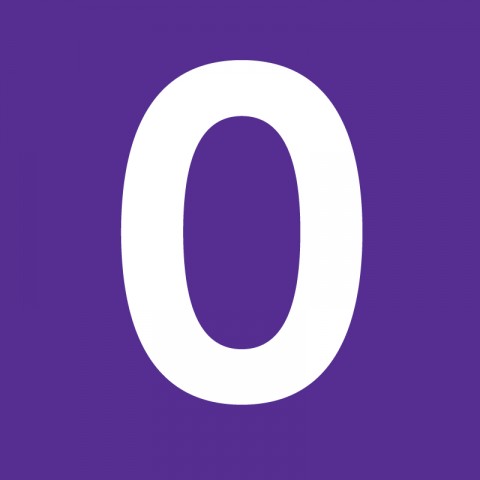So, what are Arabic numbers?
Arabic numbers are, perhaps, one of the most challenging things for Arabic learners. Numbers in Arabic language-learning may be difficult, but they’re so vital to language mastery!
Have you ever been listening to a pleasant conversation in a language you understand, then suddenly get hit with something like “…and then, on a date that would live in infamy…”
Poof. There goes your comprehension. You’ll never know when it happened.
It’s really hard to truly internalize the rules for a new number system to the point where you can hear and understand the numbers being spoken to you. And on top of that, if the numbers are relatively complex, it takes even more time to produce numbers on demand.
For that reason, the best thing you can do is to never shy away from practicing the numbers, whenever and wherever you can. When striving to really learn basic Arabic numbers, lessons like this one are a good place to start. The first step is to understand the system as a whole.
Table of Contents
- Just How Arabic are these Numerals?
- Cardinal Numbers Zero to Ten
- A Taste of Numbers in Colloquial Arabic
- Ordinal Numbers
- Some Very Easy Math
- Lemme Get Your Number
- Checking the Time
- Conclusion: How ArabicPod101 Can Help You Learn More Arabic
1. Just How Arabic are these Numerals?
In the United States, we call our numbers “Arabic numerals.” In fact, they’re called that pretty much all over the world. Even in China, the word for Arabic digits (as opposed to Chinese digits) is “Arabic numbers.”
Perhaps the only exception is where they speak Arabic.
It turns out that what English-speakers know as “Arabic numbers” are actually Western Arabic numbers. Those get called “Hindu-Arabic numerals” or نظام العد الهندي العربي (niẓām al-ʿad al-hindī al-ʿarabī) in the Arabic language.
So what are Arabic numerals?
Eastern Arabic numerals are still regularly used in Arabic writing, and so that’s what we’ll focus on today. However, it’s important (and perhaps reassuring) to note that Western Arabic digits are universally understood. In fact, in many public displays such as street signs or advertising, they’ve actually displaced the Eastern Arabic ones.
Let’s have a look at these numbers, go over the Arabic number formats, and get started using them in Modern Standard Arabic to help you better understand about counting numbers in Arabic languages.
2. Cardinal Numbers Zero to Ten
Let’s learn the Arabic numbers 1 to 10 (or rather, 0 to 10). The simplest thing to start with is zero. Without zero, it would be pretty hard to get math off the ground at all.
By the way, we also have a simple Arabic number vocabulary list you can check out first. Here, you can hear each word pronounced and see it accompanied by an image of its English numeral!
| Number | Eastern Arabic Numeral | Pronunciation |
|---|---|---|
| Zero | ٠ | صِفْر (sifr) |
| One | ١ | واحد (waḥid) |
| Two | ٢ | إثْنان (ʾiṯnān) |
| Three | ٣ | ثَلاثة (ṯalāṯah) |
| Four | ٤ | أربَعة (ʾarbaʿah) |
| Five | ٥ | خَمْسة (ḫamsah) |
| Six | ٦ | سِتّة (sittah) |
| Seven | ٧ | سَبعة (sabʿah) |
| Eight | ٨ | ثَمانية (ṯamāniyah) |
| Nine | ٩ | تِسعة (tisʿah) |
| Ten | ١٠ | عَشْرة (ʿašrah) |
We’re giving the Eastern Arabic numerals here, though on many signs and public notices you’ll see the Western Arabic forms (1, 2, 3) that you’re already used to. This is particularly true for places (such as Pakistan) which use an Arabic-derived alphabet but have a large population of English-speakers.
Now onward to 100!
| Number | Eastern Arabic Numeral | Pronunciation |
|---|---|---|
| Eleven | ١١ | إحدى عشر (ʾiḥdā ʿašar) |
| Twelve | ١٢ | إثنا عشر (ʾiṯnā ʿašar) |
| Thirteen | ١٣ | ثلاثة عشر (ṯalāṯatu ʿašar) |
| Fourteen | ١٤ | أربعة عشر (ʾarbaʿaẗu ʿašar) |
| Fifteen | ١٥ | خمسة عشر (ḫamsaẗu ʿašar) |
| Sixteen | ١٦ | ستة عشر (sittaẗa ʿašar) |
| Seventeen | ١٧ | سبعة عشر (sabʿaẗa ʿašar) |
| Eighteen | ١٨ | ثمانية عشر (ṯamāniyaẗa ʿašar) |
| Nineteen | ١٩ | تسعة عشر (tisʿaẗa ʿašar) |
| Twenty | ٢٠ | عشرون (ʿišrūn) |
When it comes to numbers in Arabic, grammar and additional structure rules are important to remember. The numbers eleven through nineteen are similar in structure to their English counterparts.
- أربعة عشر
ʾarbaʿaẗu ʿašar
Four ten (fourteen)
What’s the deal, though, with the order of digits? There’s no mistake here. The Arabic digits are written left to right, opposite from the rest of the script.
As strange as that sounds, it’s actually about to make a little more sense when you see the numbers after twenty.
- واحد و عشرون
waḥid wa ʿišrūn
one and twenty (21) - سبعة وعشرون
sabʿah wa ʿišrūn
seven and twenty (27)
And we simply follow that pattern up through ninety-nine. Germans and German learners should feel right at home.
So you see, as Arabic speakers read running text right to left, they don’t have to readjust their speech for two-digit numbers, as their eyes run into the ones place first, then the tens.
1- Counting Things Part 1: Counting to Two
Where English has singular and plural, Arabic has singular, dual, and plural forms of words.
Because of this explicit grammar marking, the Arabic singular and dual forms also capture the feeling of having “one” or “two” of something.
- كتاب
kitab
One book - كتابان
kitaban
Two books
If you really need to emphasize the number, you actually put the number after the item described. Since the number is an adjective, it has to match the noun in its case and gender.
- كتابٌ واحدٌ
itābun waḥidun
One book (one single, solitary book) - رسالتان اثْنَتان
risal-atān iṯnatān
Two letters (no more and no less)
2- Counting Things Part 2: Universal Reverse Agreement
After two, counting and the Arabic number system in general are more difficult. People say it’s the hardest part of MSA grammar by far, simply because it involves so much memorization.
To keep from overwhelming you, this guide will only touch on counting things from three to ten.
It’s important to note here that lots and lots of people speaking MSA simply don’t bother with these rules. Different colloquial varieties have already reduced, or eliminated entirely, the agreement between number and noun, and most people who speak MSA aren’t going to be pedantic enough to insist on correct number grammar in speech.
The next section is going to go into more detail about colloquial numbers, but for now, let’s focus on the rules for MSA.
When counting one and two, you put the number after the noun; when counting from three to ten, you put the number before the noun. This makes a bit of sense, really, for a language with a distinction between singular, dual, and plural. When talking about one or two things, it’s only natural for native speakers to simply use that noun form.
The fact that there is a difference is the part that makes sense. It’s a little bit harder to explain why the difference manifests in the way it does.
What ends up happening is that the noun becomes plural, declines in the genitive case, and the number takes the opposite grammatical gender.
This is called reverse agreement. It works the same way with every single noun (as long as we’re talking about three to ten).
So let’s look at the noun “teacher.” This is a masculine noun in Arabic, so if we want to say “three teachers,” it will look like this:
- ثلاثة مدرسين
ṯalāṯaẗu mudarrisīn
Three of-teachers (three teachers; “teacher” is genitive plural)
There’s a word مُدَرِّسة (madrasa) which refers specifically to a female teacher. What about three madrasas? Genitive plural, male number:
- ثلاث مدرسات
ṯalāṯu mudarrisāt
Three of-female-teachers
It may be a lot to take in at first glance, but it’s entirely rule-governed. And think about which numbers of things you mention in your daily life—two sheets of paper, four bananas, etc. If you learn the rules well, you’ll cover most of the numbers that life throws at you.
Mastering this will also make you feel like a total grammar superhero. If that’s not enough motivation (for whatever reason!), have a quick glance at how numbers get used outside of MSA rule books.
3. A Taste of Numbers in Colloquial Arabic
The simplest shortcut is to always use the masculine form of the number without changing it. This is a marker of efficiency when speaking MSA. Absolutely everybody will understand you, and nobody will blame you for not remembering the artificial rules.
What exactly is the difference between numbers in MSA and numbers in different colloquial varieties of Arabic? Have a look at this table.
| Digit | MSA | Egyptian Arabic | Moroccan Arabic |
|---|---|---|---|
| ٠ | صِفْر (sifr) | صِفْر (sifr) | صفر (sifr) |
| ١ | واحد (waḥid) | واحد (waḥid) | واحد (waḥed) |
| ٢ | إثْنان (ʾiṯnān) | إثْنان (ʾiṯnen) | جوج (zouj) |
| ٣ | ثَلاثة (ṯalāṯah) | ثَلاثة (ṯalāṯah) | تلاتة (telata) |
| ٤ | أربَعة (ʾarbaʿah) | أربَعة (ʾarbaʿah) | ربعة (reb’a) |
| ٥ | خَمْسة (ḫamsah) | خَمْسة (ḫamsah) | خمسة (ḫemsa) |
| ٦ | سِتّة (sittah) | سِتّة (sittah) | سْتة (setta) |
| ٧ | سَبعة (sabʿah) | سَبعة (sabʿah) | سْبعة (seb’a) |
| ٨ | ثَمانية (ṯamāniyah) | ثَمانية (ṯamānyah) | تْمنية (tmenya) |
| ٩ | تِسعة (tisʿah) | تِسعة (tisʿah) | تْسعود (tes’od) |
| ١٠ | عَشْرة (ʿašrah) | عَشْرة (ʿašrah) | عْشرة (‘eshra) |
As you can see, with the numbers zero through ten, there aren’t any enormous differences in pronunciation (though short vowels tend to disappear in Moroccan Arabic in particular).
After a little bit of getting used to the way different people say these numbers, you’ll be able to understand all of them with no trouble at all.
The grammar is also significantly simplified. There’s still a dual form and masculine and feminine agreement, but all colloquial varieties of Arabic have lost their cases entirely.
4. Ordinal Numbers
The definite article is attached to all of these, so you should really read the English as “the first, the second,” etc.
The masculine form of the numbers is presented here.
| First | ألأَوَّلُ | al-awwal |
| Second | الثّاني | aṯ-ṯani |
| Third | الثّالِثُ | aṯ-ṯaleṯ |
| Fourth | الرّابِعُ | arrabe’ |
| Fifth | الْخامِسُ | al-ḫaames |
| Sixth | السّادِسُ | assadis |
| Seventh | السابعُ | assabe’ |
| Eighth | الثّامِنُ | aṯṯamen |
| Ninth | التّاسِعُ | attase’ |
| Tenth | الْعاشِرُ | al-ʿašer |
One thing to note as the numbers climb higher and higher: Numbers that are multiples of ten form their ordinal with a simple prefix.
So that means we have أربعون (arba’un) or “forty,” which takes the prefix al– to mean “fortieth.” The number seventy is سبعون (sab’un), and its prefix is a– because it doesn’t start with a vowel. Thus asab’un is how you would say “seventieth.”
5. Some Very Easy Math
Numbers are written from left to right, but math isn’t. Have a look at this:
- ١+٣ =٤
واحد جمع ثَلاثة يساوي أربَعة
waḥid ǧamʿ ṯalāṯah yusāūī ʾarbaʿah
one plus three equals four
You might not think you need to know words for math, but if you live in an Arabic-speaking environment, the words “plus”, “minus”, and “equals” show up relatively often.
- جمع
ǧamʿ
plus - طرح
tarḥ
minus - يساوي
yusawi
equals
One other thing to note is the way people say percentages. It’s as easy as pie! You say the number and then use the Arabic word for “percent.”
- عشرون بالمائة
ʿišrūn bilmiʾah
twenty percent
6. Lemme Get Your Number
Phone numbers in different Arabic countries vary pretty strongly in length.
In Tunisia, for instance, phone numbers are six digits with a two-digit area code. In Egypt, landlines are seven digits and mobile numbers are eight. And in Iraq, mobile numbers are ten digits, including a separate prefix for each telecom.
Some languages like German, Mandarin, and even English use separate variants of the digits when reciting phone numbers. Imagine the struggles (perhaps you don’t have to imagine) of an English-learner hearing “My number is five oh four, triple two, seventy-eight fourteen.”
There’s quite a bit of mental gymnastics going on to convert that to 504-222-7814.
But for perhaps the first time in this article, Arabic learners can take the easy road. Check out these phrases.
- ما رقم هاتفك؟
mā raqmu hātifik?
What is your telephone number? - رقم هاتفي هو.
raqmu hātifi huwa…
My telephone number is…
And then? All you do is say each digit individually. tis’a wahid wahid sitta… (9117…).
Now, in colloquial variants of Arabic, people may have their own individual systems. But when speaking MSA, people tend to slow down and speak more clearly anyway. For that reason, they’ll keep phone number recitals as simple as can be.
Oh, and if you’re exchanging phone numbers in Arabic, you may find it helpful to know some vocabulary for talking about the days in Arabic! Also keep your eyes peeled for our upcoming Dates in Arabic article so you can start setting up appointments and dates.
7.Checking the Time
Remember those differences between MSA and colloquial numbers? Here’s a huge one.
Colloquial varieties of Arabic use the cardinal numbers to tell time. So to say that it’s three o’clock in Egyptian Arabic, you would literally just say الساعة ثلاثة (el-sa’ah talaata) or “three o’clock” and leave it at that.
In MSA, though, you need the ordinal numbers.
- الساعةُ الواحدة
al-sāʿaẗu al-waḥida
one o’clock - الساعةُ الثامنة
al-sāʿaẗu al-ṯāminah
eight o’clock - كم الساعةُ؟ الساعةُ الثانية.
kam al-sāʿaẗu? al-sāʿaẗu al-ṯāniyah.
What time is it? Two o’clock.
It’s not too hard to start using these as there aren’t any complicated rules about declension or agreement. Just remember that if you really want to stick to the grammar of MSA as much as possible, use the ordinal forms.
Besides, it’s what you’ll hear on the news anyway.
8. Conclusion: How ArabicPod101 Can Help You Learn More Arabic
Like any aspect of language, the use of numbers in Arabic can seem to get more and more complex the more you look at it.
But your native language is guaranteed to have just as many things that can seem equally maddening to Arabic speakers.
It’s all a matter of exposure. The more you hear and use this number system, the more you get used to it, and then at some point it’ll seem completely crazy that you ever had trouble remembering the cases.
So embrace the challenge. Embrace the complexity of Arabic numbers, and come out knowing that you’ve mastered one of the most difficult challenges in Arabic learning. And that’s saying something!
Know that ArabicPod101.com will be here with you on each step of your language-learning journey with tons of practical and fun learning tools! You can do this!
Author: Yassir Sahnoun is a HubSpot certified content strategist, copywriter and polyglot who works with language learning companies. He helps companies attract sales using content strategy, copywriting, blogging, email marketing & more.

















